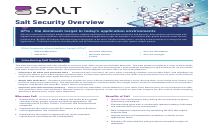
Salt Security
Founded Year
2016Stage
Unattributed VC | AliveTotal Raised
$280.74MAbout Salt Security
Salt Security focuses on API security and provides a platform to protect APIs throughout their lifecycle. The company's services include API discovery, posture management, threat protection, incident response, and remediation insights, targeting sectors that rely on application programming interfaces for digital operations and data exchange. Salt Security was formerly known as Secful. It was founded in 2016 and is based in Palo Alto, California.
Loading...
Salt Security's Product Videos


ESPs containing Salt Security
The ESP matrix leverages data and analyst insight to identify and rank leading companies in a given technology landscape.
The WAAP market is focused on protecting the APIs that form the core of modern applications. This includes preventing next-generation API attacks and providing protection across build, deploy, and runtime phases. Solutions in this market offer unique API design analysis in pre-production, continuous monitoring for compliance, and the ability to detect and block bad actors before they reach their o…
Salt Security named as Leader among 14 other companies, including Akamai, Palo Alto Networks, and Check Point.
Salt Security's Products & Differentiators
Salt Security API Protection Platform
The Salt Security API Protection Platform, enables organizations to protect their APIs across build, deploy, and runtime phases. Through its unique API Context Engine (ACE) architecture, the Salt platform is able to discover all APIs and the sensitive data that they expose, identify API vulnerabilities in pre-production testing, stop API attackers, prevent data exfiltration, account takeovers, and service disruption, provide remediation insights, and simplify compliance. The platform taps its big data engine to collect and analyze the activity of millions of users in parallel, across millions of APIs. This architecture allows the Salt platform to piece together the subtle probing of an attacker during reconnaissance, assess the risk of their activity, and pinpoint and stop them early in their process.
Loading...
Expert Collections containing Salt Security
Expert Collections are analyst-curated lists that highlight the companies you need to know in the most important technology spaces.
Salt Security is included in 2 Expert Collections, including Unicorns- Billion Dollar Startups.
Unicorns- Billion Dollar Startups
1,270 items
Cybersecurity
10,704 items
These companies protect organizations from digital threats.
Salt Security Patents
Salt Security has filed 1 patent.

Application Date | Grant Date | Title | Related Topics | Status |
|---|---|---|---|---|
4/13/2016 | 12/26/2017 | Application programming interfaces, Data modeling, Database management systems, Data management, Cyberwarfare | Grant |
Application Date | 4/13/2016 |
|---|---|
Grant Date | 12/26/2017 |
Title | |
Related Topics | Application programming interfaces, Data modeling, Database management systems, Data management, Cyberwarfare |
Status | Grant |
Latest Salt Security News
Mar 27, 2025
Security Boulevard Community Chats Webinars Library Reality Bites: You’re Only as Secure as Your Last API Deployment In agile and DevOps-driven environments, APIs are frequently updated to meet evolving business demands, from adding new features to addressing performance issues. However, each deployment introduces potential security risks, as new code, configurations, and endpoints can expose vulnerabilities. In an environment of continuous integration and continuous deployment (CI/CD), the security of an organization’s APIs hinges on rigorous, continuous testing and proactive risk management. The Constant Security Risks of Frequent API Updates While frequent deployments are essential for innovation and responsiveness, they also necessitate a robust security strategy to avoid exposing new vulnerabilities with each release. The top five challenges associated with rapid API development cycles as well as best practices for secure deployment are explored below. 1. Increased Vulnerability from Rapid Changes Agile development emphasizes speed, often prioritizing feature delivery over security testing. In this environment, APIs undergo constant changes, with updates deployed to production in near-real time. This rapid deployment cadence can lead to security oversight, as some vulnerabilities may slip through due to time constraints or inadequate testing. Each new deployment introduces the possibility of misconfigurations, improper access controls, or overlooked vulnerabilities in business logic. The frequent changes also make it difficult for security teams to maintain an accurate, up-to-date understanding of the API’s security posture, leading to potential blind spots in protection. Take an e-commerce company that makes an update to allow third-party integrations for instance. If the deployment left just one endpoint open with insufficient access controls, then the retailer could experience a security breach due to unauthorized access to customer data. If these types of vulnerabilities are missed in the rush to launch, they could soon realize the threat associated with the rapid deployment of under-tested API changes. How to Avoid These Risks: Adopting a “security as code” approach within the CI/CD pipeline to ensure that security checks are integrated into each stage of the deployment process is a huge step to preventing these missed vulnerabilities. This allows vulnerabilities to be identified early, minimizing the risk of pushing insecure APIs to production. 2. Inadequate Security Testing in Agile and CI/CD Workflows Traditional security testing tools and processes, such as static application security testing (SAST) or dynamic application security testing (DAST), are often too slow for CI/CD workflows. These methods require manual intervention or time-consuming scans, which conflict with agile timelines. As a result, some organizations forgo comprehensive testing in favor of speed, leaving APIs vulnerable to exploits. APIs require specialized security testing that goes beyond traditional application testing, particularly in identifying issues like broken object-level authorization (BOLA) or excessive data exposure. Without dedicated API security testing integrated into the CI/CD process, these vulnerabilities can be pushed into production and remain undetected until exploited. For example, let’s say a fintech start-up didn’t realize there was a flaw in its API’s authorization logic because the vulnerability was not detected in pre-deployment testing – the most basic of application security tests on which it relied. The oversight could allow attackers to exploit the API and access unauthorized financial data, which could be detrimental to the start-up’s future success. How to Make Testing More Impactful: Organizations should implement dedicated API security testing within CI/CD pipelines, using automated tools that cover both static and dynamic analysis. API-specific tests should include fuzzing, schema validation, and business logic verification to catch vulnerabilities unique to APIs before deployment. 3. Shadow and Zombie APIs from Frequent Development Cycles In fast-moving development environments, it’s common for APIs to be modified or replaced frequently. However, APIs that are no longer in use are often left active in production, creating shadow or zombie APIs. These abandoned APIs are rarely monitored or updated, making them easy targets for attackers seeking unguarded entry points into the system. Shadow APIs are undocumented and thus bypass traditional monitoring and security measures, while zombie APIs may use outdated authentication methods or lack modern security updates. Both types of APIs represent significant vulnerabilities, as they often retain access to sensitive data or functions that attackers can exploit. For instance, in 2023, a healthcare provider discovered that an outdated API left active in production was being exploited by attackers to retrieve sensitive patient records. The API, originally designed for a now-discontinued mobile app, had been forgotten by the development team and was vulnerable due to its outdated security configuration. Combating shadow and Zombie APIs: Organizations should implement API lifecycle management as part of the development process to ensure that inactive APIs are properly decommissioned. Furthermore, you can’t know what you can’t see, so automated discovery tools can help identify shadow and zombie APIs, allowing security teams to monitor, update, or remove them as needed. 4. Real-Time Monitoring and Risk Scoring for Ongoing Security Static security assessments conducted at predefined intervals fail to provide the visibility needed for a continuously evolving API ecosystem. Given the speed and frequency of API updates, real-time monitoring is essential to ensure ongoing security. Continuous monitoring enables security teams to detect unusual patterns or unauthorized access in real-time, helping them respond swiftly to potential threats. Yet, according to Salt’s latest State of API Security Report, only 13% of organizations update their APIs daily. Risk scoring involves assigning a risk level to each API endpoint based on its configuration, recent changes, and traffic patterns. By focusing on high-risk APIs—such as those recently updated or handling sensitive data—security teams can prioritize resources effectively, identifying and mitigating risks in real-time. An example could be a financial services company implementing real-time monitoring and risk scoring for its API endpoints, enabling them to detect abnormal traffic immediately following a deployment. This approach would allow them to quickly identify and address any potential vulnerabilities that could lead to unauthorized data access. How to Prioritize API Risk: Organizations can adopt an API security solution that provides continuous monitoring and assigns dynamic risk scores based on each API’s current status and interaction patterns. This approach allows security teams to quickly identify and prioritize high-risk endpoints, improving the organization’s ability to respond to emerging threats. Even better if it can use industry-specific compliance guide rails to add another layer to risk-scoring that has real-world impact. 5. Implementing a Robust API Decommissioning Process In a fast-paced development environment, decommissioning is often overlooked. APIs that are no longer in use or that have been replaced by newer versions are frequently left active in production, leading to “API sprawl” and increasing the organization’s attack surface. These abandoned APIs can become liabilities if not properly decommissioned and removed. Inactive APIs are often neglected in terms of security maintenance, leaving them vulnerable to attacks that exploit outdated protocols, insufficient authentication, or residual access permissions. This can lead to unauthorized access, data leakage, or compliance issues if sensitive data is exposed through these forgotten endpoints. A company could quite easily find themselves facing a data breach if attackers discover and exploit an inactive API endpoint. Even though this API may not have been used in over a year, because it’s not actively monitored and lacks the security updates applied to active endpoints, it would allow attackers to access the company’s internal system. Decommissioning Unused APIs: Organizations need to establish a formalized decommissioning process that ensures all APIs are securely retired and removed from production when no longer needed. This process should include a review of access controls, residual permissions, and endpoint removal, minimizing the risk of shadow or zombie APIs lingering in the system. Prioritizing Security in Every API Deployment In a CI/CD-driven world, where APIs are updated frequently to keep up with business demands, security can no longer be an afterthought. Each deployment introduces potential risks, and without a robust security framework in place, these vulnerabilities can expose an organization to significant threats. Implementing security as part of the CI/CD pipeline, continuously monitoring API interactions, and enforcing a strict decommissioning process are essential to maintaining a secure API environment. As organizations navigate the demands of agile development, they must recognize that secure APIs are the foundation of digital trust and resilience. By adopting best practices for secure API deployment, companies can protect their assets and reputation in an increasingly API-dependent world. If you want to learn more about Salt and how we can help you on your API Security journey through discovery, posture governance, and run-time threat protection, please contact us , schedule a demo , or check out our website . *** This is a Security Bloggers Network syndicated blog from Salt Security blog authored by Eric Schwake . Read the original post at: https://salt.security/blog/reality-bites-youre-only-as-secure-as-your-last-api-deployment
Salt Security Frequently Asked Questions (FAQ)
When was Salt Security founded?
Salt Security was founded in 2016.
Where is Salt Security's headquarters?
Salt Security's headquarters is located at 3921 Fabian Way, Palo Alto.
What is Salt Security's latest funding round?
Salt Security's latest funding round is Unattributed VC.
How much did Salt Security raise?
Salt Security raised a total of $280.74M.
Who are the investors of Salt Security?
Investors of Salt Security include CrowdStrike Falcon Fund, Y Combinator, Sequoia Capital, Tenaya Capital, S Capital VC and 13 more.
Who are Salt Security's competitors?
Competitors of Salt Security include Corsha, ThreatX, Traceable AI, FireTail, Noname Security and 7 more.
What products does Salt Security offer?
Salt Security's products include Salt Security API Protection Platform.
Who are Salt Security's customers?
Customers of Salt Security include Finastra and DeinDeal.
Loading...
Compare Salt Security to Competitors

Cequence specializes in API security and bot management within the cybersecurity industry. The company offers a Unified API Protection solution that encompasses discovery, compliance, and protection against attacks, business logic abuse, and fraud for applications and APIs. Cequence primarily serves sectors such as automotive, financial services, healthcare, online dating, public sector, retail, and telecom across different business sizes, from SMBs to enterprises. Cequence was formerly known as stealth security. It was founded in 2014 and is based in Santa Clara, California.

Aiculus focuses on API security within the cybersecurity domain. The company uses artificial intelligence to monitor, detect, and respond to API security threats in real-time, aiming to protect customer data and organizational reputation. Aiculus serves sectors that need API security, such as e-commerce platforms, financial services, and technology companies. It was founded in 2018 and is based in Singapore.

Apoxy is a company focused on providing solutions for API monitoring and management within the tech industry. Their platform offers tools for observing and securing API calls, as well as facilitating the evolution of API services. The company primarily caters to developers and businesses looking to enhance their API infrastructure. It was founded in 2023 and is based in San Francisco, California.

ammune.ai operates as a cybersecurity company. The company provides services to help organizations protect their infrastructure, applications, customers, employees, and partners from application program interface (API) borne attacks using autonomous artificial intelligence (AI) based solutions. It was formerly known as L7 Defense. It was founded in 2015 and is based in Jersey City, New Jersey.

Threat Hunter offers cybersecurity, addressing black industry threats and offering security solutions for enterprises. It provides services including counter-malware analysis, financial fraud prevention, and Application Programming Interface (API) data security management. It serves sectors such as finance, media, social networking, and commercial platforms. It was founded in 2017 and is based in Shenzhen, China.

Forum Systems specializes in API management and protection for various industries. The company offers products including secure API gateways, multi-factor and continuous authentication, and services for legacy system modernization and zero trust architecture implementation. Forum Systems serves government and commercial enterprises, with technology that secures and manages transactions. It was founded in 2001 and is based in Needham, Massachusetts.
Loading...
